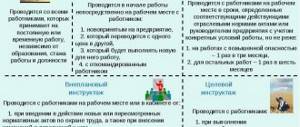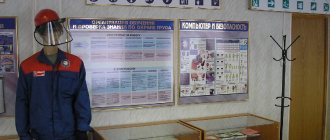Correct drafting of an order
There is no exact sample of an order on the organization of labor protection work in an organization. But he must be present at any enterprise in accordance with Art. 218 Labor Code of the Russian Federation.
Dangerous enterprise
Format
Labor protection orders (OHS) do not have an exact template, but they must be drawn up in compliance with certain rules. In this case, the following features are taken into account:
- the document should contain only important information, the text should be written in a business style;
- Each company prepares a ready-made template, taking into account the specifics of its work activities. Often the form corresponds to the same style of writing all regulations within the enterprise;
- The document is printed on a computer and printed on A4 paper. You don’t have to indicate the names of the responsible persons right away on the form; it is enough to enter them later with a pen and block letters. Responsible persons put signatures opposite their names;
- the standard document must indicate all the options necessary for strict compliance and execution by responsible persons.
The order is printed in one copy, and from 2021 it is no longer registered or certified by a seal. This is not necessary, since the document can only be certified by the signature of the head of the enterprise and stored in general documentation.
What qualification requirements apply to a specialist or occupational safety department?
The new Handbook, adopted on the basis of Order No. 559n., has somewhat revised both the titles of occupational safety specialist positions and the qualification requirements for them.
So, now the labor protection functions at the enterprise are performed by the head of the labor protection service and a labor protection specialist. According to the Handbook, they must have a higher professional education in the field of training “Technosphere Safety” or corresponding areas of training (specialties) in ensuring the safety of production activities, or higher professional education and additional professional education (professional retraining) in the field of labor protection and relevant experience. A specialist may also have secondary vocational education and additional vocational education (professional retraining) in the field of labor protection.
In their work, labor protection specialists are guided by legislative and regulatory documentation on labor protection at the federal level, the level of constituent entities of the Russian Federation, various agreements of local significance - industry, regional, etc., a collective agreement and other regulatory documentation in force in the organization.
The work of the labor protection service is directly related to the activities of other structural divisions of the organization, trade unions, labor protection services at various levels, federal and subject executive authorities, authorities exercising state and public control and supervision of compliance with labor protection standards.
*An employer or work team can take the initiative and organize a committee or commission on labor protection. Such an association includes representatives from the employer and employees represented by a trade union or other authorized body. The key task of this commission is to ensure labor safety standards, prevent industrial accidents and occupational diseases, as well as organize inspections of working conditions and inform employees about them in order to optimize the relevant section of the collective agreement.
Who signs the order?
Order on conducting labor protection training for employees of the organization
The order must be signed by all persons indicated in the text. In this way, employees responsible for occupational safety become familiar with their responsibilities and confirm their acceptance for compliance. The purpose of the order is to select and officially approve workers who will check compliance with safety regulations at the enterprise, for which they will periodically conduct briefings.
Note! After those responsible for safety issues have signed the document, the document is certified by the management - the director of the organization. An order on labor protection acquires legal force only after the document is signed by the head of the company.
According to Art. 209 of the Labor Code of the Russian Federation, all enterprises must have the presented type of document. The absence of an order entails administrative liability with a fine of 80 thousand rubles*.
List of documents required for organizations
We create a labor protection service
Despite the fact that in organizations where the number of employees exceeds 50 people, the presence of an occupational safety service is mandatory, the employer does not always want to spend effort and money on this, and in vain, since most violations in the field of labor legislation relate specifically to violations in the field of occupational safety. Even if the organization is small, we recommend that employers do not skimp on worker safety and create their own occupational safety service. We will tell you how to do this in the article.
Labor legislation establishes that every organization, regardless of its form of ownership, must comply with state regulatory requirements for labor protection, including labor safety standards, as well as labor protection requirements established by the relevant rules and instructions. State regulatory requirements for labor protection, contained in federal laws, other regulatory legal acts of the Russian Federation, laws and other regulatory legal acts of constituent entities of the Russian Federation, establish rules, procedures, criteria and standards aimed at preserving the life and health of workers in the process of work.
The implementation of the main directions of state policy in the field of labor protection is ensured by the coordinated actions of state authorities of the Russian Federation, state authorities of constituent entities of the Russian Federation and local governments, employers, associations of employers, as well as trade unions, their associations and other representative bodies authorized by employees on labor protection issues.
In addition, targeted programs are periodically developed in the constituent entities of the Russian Federation aimed at improving labor conditions and safety in order to reduce professional risks by employees of all organizations, regardless of their organizational, legal forms and forms of ownership.
Since the implementation of various labor protection measures in an organization requires quite a lot of effort and time, specially trained people should do this. At the same time, the number of occupational safety specialists in the organization depends on the number of employees. According to the requirements of Art. 217 of the Labor Code of the Russian Federation, if the number of employees of an organization exceeds 50 people, an occupational safety service is created or the position of an occupational safety specialist is introduced. If the number of employees does not exceed 50 people, the employer independently decides to create a labor protection service or introduce the position of a labor protection specialist, taking into account the specifics of its production activities.
Note! According to Art. 209 of the Labor Code of the Russian Federation, production activity is understood as a set of actions of workers using means of labor necessary to transform resources into finished products, including the production and processing of various types of raw materials, construction, and the provision of various types of services. By virtue of Art. 779 of the Civil Code of the Russian Federation, services include the performance of certain actions or activities, including in the field of communication services, medical, veterinary, auditing, consulting, information services, training services, tourism services and other services.
We note that in accordance with Part 3 of Art. 217 of the Labor Code of the Russian Federation in small organizations where the number of employees does not exceed 50 people, in the absence of an occupational safety service or the position of an occupational safety specialist, these functions can be performed by:
— individual entrepreneur (personally);
- Head of the organization;
- employee authorized by the employer;
- an organization or specialist providing services in the field of labor protection, engaged by the employer under civil law contracts.
At the same time, all persons who can engage in labor protection must undergo training in labor protection established by the Procedure for training in labor protection and testing knowledge of labor protection requirements for employees of organizations and testing knowledge of labor protection requirements for employees of organizations, approved by the Resolution of the Ministry of Labor of the Russian Federation, the Ministry of Education of the Russian Federation dated 13.01 .2003 N 1/29. Training is carried out according to relevant labor protection programs directly by the organization itself or by training organizations. Training is carried out upon entry to work during the first month, then - as needed, but at least once every three years.
As for services in the field of labor protection, they can only be provided by accredited organizations. The list of services for which accreditation is required, and the accreditation rules are approved by Order of the Ministry of Health and Social Development of the Russian Federation dated April 1, 2010 N 205n.
The structure of the labor protection service and its number are determined by the head of the organization depending on the number of employees, the nature of working conditions, the degree of danger of production and other factors, taking into account the Intersectoral Standards approved by Resolution of the Ministry of Labor of the Russian Federation of January 22, 2001 N 10 (hereinafter referred to as the Standards). Along with the Standards, Recommendations for organizing the work of the labor protection service in an organization, approved by Resolution of the Ministry of Labor of the Russian Federation dated 02/08/2000 N 14 (hereinafter referred to as the Recommendations), are applied.
So, first of all, the manager should determine who will perform the function of a labor protection specialist: a separate structural unit, a labor protection specialist, the manager himself, a person authorized by him or a third-party organization.
Please note that according to the Standards, in organizations with an average number of employees (in the absence of workers engaged in heavy work or work associated with harmful and dangerous working conditions) up to 700 people, it is enough to have a separate labor protection specialist (specialists). In organizations with larger numbers, an occupational safety bureau is created, consisting of three to five employees, or a department, consisting of six or more employees. An example of calculating the number of personnel of the labor protection service depending on the average number of employees of the organization, the number of workers engaged in heavy work and work associated with hazardous working conditions, the number of structural divisions and other indicators is given in the Standards.
The manager's decision is reflected in the order. At the same time, if an occupational safety service is created in the form of a structural unit or one occupational safety specialist is hired, it is necessary to make changes to the staffing table (if the unit or specialist position was not provided for by it).
It is also necessary to develop a regulation on the labor protection service, which establishes the goals and objectives of such a service, rights and responsibilities, the procedure for interaction with other departments, etc.
In addition to the regulations on the labor protection service, it is necessary to develop job descriptions. When developing instructions, the Qualification Directory of Positions for Managers, Specialists and Other Employees, approved by Resolution of the Ministry of Labor of the Russian Federation dated August 21, 1998 N 37, is currently used (hereinafter referred to as the Directory of Positions).
For your information. On July 1, 2013, the Unified Qualification Directory of Positions for Managers, Specialists and Employees, section “Qualification Characteristics of Positions of Specialists Carrying Out Work in the Field of Occupational Safety and Health”, approved by Order of the Ministry of Health and Social Development of the Russian Federation dated May 17, 2012 N 559n (hereinafter referred to as Order N 559n) comes into force. .
The order to carry out all measures to create a labor protection service can be reflected in one order. Let's give an example of it.
| Limited Liability Company "Saturn" |
| (Saturn LLC) |
| Moscow | January 21, 2013 |
In order to organize work on labor protection in accordance with Art. 217 Labor Code of the Russian Federation
I order:
1. Create a structural unit in Saturn LLC - “Occupational Safety and Health Department” with 2 staff units:
— head of the labor protection department — 1 staff unit;
– occupational safety specialist – 1 staff unit.
2. Make appropriate changes to the staffing table.
3. Head of HR Department L.V. Maximova:
3.1. Prepare changes to the staffing table and submit it for approval by 02/27/2013.
3.2. Develop Regulations on the Occupational Safety and Health Service and job descriptions for employees of the Occupational Safety and Health Department by 03/10/2013.
3.3. Submit proposals for staffing the service with employees of the required qualifications by March 20, 2013.
4. I reserve control over the execution of the order.
| Director | Karpov | K.I. Karpov |
| I have read the order: | ||
| Head of HR Department | Maksimova | L.V. Maksimova |
Please note that the organization's labor protection service reports directly to the head of the organization or (on his instructions) to one of his deputies.
If the manager considers it inappropriate to create an entire department or hire a labor protection specialist, he can assign the specialist’s responsibilities to another employee of the organization in the order of part-time work or combining professions. Do not forget that this can only be done in organizations with fewer than 50 employees. In this case, the position of a labor protection specialist must be provided for in the staffing table.
The assignment of the duties of a labor protection specialist to another employee is also carried out by order of the manager. Here is a sample of such an order.
| Limited Liability Company "Saturn" |
| (Saturn LLC) |
| Moscow | January 21, 2013 |
I order:
1. Assign the duties of a labor protection specialist in accordance with the staffing table on the basis of combining positions in accordance with Part 2 of Art. 60.2 of the Labor Code of the Russian Federation for Deputy Director for Administrative and Economic Affairs Vasily Ivanovich Loginov.
2. Chief accountant E.M. Danilova:
install V.I. Loginov receives a monthly additional payment for performing additional work in order to combine positions in the amount of 10,000 rubles.
3. Send V.I. Loginova to study at the Center for Vocational Education.
4. Head of HR Department L.V. Maximova:
prepare an agreement with the Center for Vocational Education for the training of V.I. Loginova.
5. V.I. Loginov:
begin performing duties as an occupational safety specialist the next day after completing the occupational safety training.
Reason: additional agreement to the employment contract dated 02.10.2011 N 25/11.
| Director | Karpov | K.I. Karpov |
| I have read the order: | ||
| Chief Accountant | Danilova | EAT. Danilova |
| Head of HR Department | Maksimova | L.V. Maksimova |
| Deputy Director for Administrative and Economic Affairs | Loginov | IN AND. Loginov |
Let us remind you that when working part-time, an employment contract is concluded with the employee, and the work is performed in his free time from the main job (Article 60.1 of the Labor Code of the Russian Federation). When working on a part-time basis, work is performed during the established duration of the working day (shift) along with the work specified in the employment contract, with the written consent of the employee (Article 60.2 of the Labor Code of the Russian Federation). When combining positions, an additional agreement to the employment contract is concluded with the employee. Before signing an employment contract or additional agreement with an employee, it is necessary to familiarize the occupational safety specialist with the job description and other local regulations in the field of occupational safety, against signature.
If the head of an organization (individual entrepreneur) with less than 50 employees assigns the responsibilities of a labor protection specialist to himself, no order needs to be issued, since he is already obliged to ensure safe conditions and labor protection in the organization (Article 212 of the Labor Code of the Russian Federation). In addition, managers, along with occupational safety specialists, undergo special training in occupational safety and health within the scope of their job responsibilities upon entering work during the first month, then as necessary, but at least once every three years.
Newly appointed managers are allowed to work independently after they have been familiarized by the employer (or a person authorized by him) with job responsibilities, including labor protection, local regulations in force in the organization that regulate the procedure for organizing work on labor protection, and working conditions in the areas entrusted to them. objects (in structural divisions of the organization) (clause 2.3.1 of the Recommendations).
The legislation establishes certain requirements for a person holding the position of occupational safety specialist. Thus, the Directory of Positions, in addition to job responsibilities, establishes qualification requirements for the positions of “head of the labor safety department” and “labor safety engineer.” The head of the department must have a higher professional (technical) education and work experience in labor protection in engineering, technical and managerial positions for at least five years. An occupational safety engineer, depending on the category, must have a higher or secondary vocational (technical) education and a certain amount of work experience as an occupational safety engineer, another engineering position, or a technician position.
In the new directory, approved by Order N 559n, the qualification requirements have changed slightly. First of all, the job titles have changed. Now they are called “the head of the labor protection service” and “the labor protection specialist.” Both the manager and the specialist (depending on the category) must have a higher professional education in the field of training “Technosphere Safety” or corresponding areas of training (specialties) in ensuring the safety of production activities, or higher professional education and additional professional education (professional retraining) in the field labor protection and relevant experience. A specialist may also have secondary vocational education and additional vocational education (professional retraining) in the field of labor protection.
Employees of the labor protection service in their activities must be guided by laws and other regulatory legal acts on labor protection of the Russian Federation and the corresponding constituent entity of the Russian Federation, agreements (general, regional, sectoral), collective agreement, agreement on labor protection, and other local regulatory legal acts of the organization.
The labor protection service carries out its activities in cooperation with other divisions of the organization, the labor protection committee (commission), authorized (trusted) persons for labor protection of trade unions or other representative bodies authorized by employees, the labor protection service of a higher organization (if any), and also with federal executive authorities and the executive authority of the relevant constituent entity of the Russian Federation in the field of labor protection, state supervision and control bodies over compliance with labor protection requirements and public control bodies.
For your information. At the initiative of the employer and (or) employees or their representative body, labor protection committees (commissions) are created, which include representatives of the employer and representatives of the elected body of the primary trade union organization or other representative body of employees. The committee (commission) organizes joint actions of the employer and employees to ensure labor safety requirements, prevent occupational injuries and occupational diseases, and also organizes inspections of labor conditions and safety in the workplace and informing employees about the results of these inspections, collecting proposals for the section of the collective agreement ( agreement) on labor protection (Article 218 of the Labor Code of the Russian Federation).
The main tasks of the labor protection service according to the Recommendations are:
— organizing work to ensure that employees comply with labor protection requirements;
— control over employees’ compliance with laws and other regulatory legal acts on labor protection, collective agreements, agreements on labor protection, and other local regulatory legal acts of the organization;
— organization of preventive work to prevent industrial injuries, occupational diseases and diseases caused by production factors, as well as work to improve working conditions;
— informing and consulting the organization’s employees, including its manager, on labor safety issues;
— study and dissemination of best practices in labor protection, promotion of labor protection issues.
The conditions for employees of the labor protection service to fulfill their powers are created by the manager. He also controls the activities of the labor protection service. Control is also carried out by the labor protection service of a higher organization (if there is one), the executive authority of the relevant constituent entity of the Russian Federation in the field of labor protection, and state supervision and control bodies over compliance with labor protection requirements.
The head of the organization is also responsible for the activities of the service. Service employees are responsible for fulfilling their job responsibilities as defined by the regulations on the labor protection service and job descriptions.
One of the important conditions for the normal functioning of the labor protection service is the organization by the employer of an office or labor protection corner. It is recommended to organize the workplaces of service workers in a separate room, provide them with modern office equipment, technical means of communication and equip them to receive visitors. And to carry out a number of functions (training, briefing, seminars, lectures, exhibitions), it is necessary to provide for the organization of a labor protection office, equipped with the necessary regulatory legal and reference literature on labor protection (clauses 11, 12 of the Recommendations).
To help employers create offices and corners for labor protection, Resolution of the Ministry of Labor of the Russian Federation of January 17, 2001 N 7 approved the corresponding recommendations. Let's consider their main provisions.
Thus, it is recommended to allocate a special room for the occupational safety office in an organization, consisting of one or several rooms (offices), which is equipped with technical means, teaching aids and samples, illustrative and information materials on occupational safety.
The occupational safety corner is designed depending on the area allocated for its placement. For example, it can be presented in the form of a stand, a showcase or screen, or a computer program.
In organizations carrying out production activities with 100 or more employees, as well as in organizations whose specific activities require a large amount of work with staff to ensure occupational safety, it is recommended to create an occupational safety office, and in organizations with less than 100 employees and their structural divisions - labor protection corner.
The premises for the occupational safety cabinet must comply with the requirements of building codes and regulations. It is recommended to determine its area based on the number of employees in the organization: up to 1,000 people - 24 sq. m, over 1,000 people - plus 6 sq. m for every additional thousand people. At the same time, either a separate room or part of a general purpose room can be allocated for the occupational safety corner.
In organizations whose production activities involve the movement of workers around facilities and being in temporary work areas (for example, when working on a rotational basis), it is advisable to equip mobile offices and occupational safety corners.
The main activities of the office and occupational safety corner include:
— providing effective assistance in solving labor safety problems;
— creation of a system for informing workers about their rights and responsibilities in the field of labor protection, the state of conditions and labor protection in the organization, at specific workplaces, adopted regulatory legal acts on labor safety and health;
— propaganda of labor issues.
The following activities are carried out in occupational safety rooms:
— holding seminars, lectures, conversations and consultations on labor protection issues;
— training in labor protection, including safe methods and techniques for performing work, the use of collective and individual protective equipment, and issues of first aid;
— conducting labor safety briefings, thematic classes with employees who are required to have special knowledge of labor protection and sanitary standards, and testing knowledge of workers’ labor protection requirements;
— organization of exhibitions, expositions, stands, models and other forms of visual propaganda and promotion of best practices in creating healthy and safe working conditions;
— conducting analytical studies of the state of working conditions in the organization (workplaces) and assessing their impact on the safety of work.
The occupational safety corner provides workers with information about schedules of briefings and training sessions on occupational safety, orders and regulations related to the organization’s occupational safety issues, plans to improve conditions and occupational safety, harmful and hazardous production factors and protective equipment at the workplace of a structural unit ( site), violations of labor protection legislation, cases of industrial injuries and occupational diseases in the organization and measures taken to eliminate their causes, new receipts in the labor protection office of documents, educational and methodological literature, educational videos on labor protection, etc.
The thematic structure of the office and occupational safety corner involves the inclusion of general and special sections.
The general section contains laws and other regulatory legal acts on labor protection adopted at the federal level and the level of the corresponding constituent entity of the Russian Federation, local regulatory acts of the organization, information on the management of labor protection in the organization, as well as general information on ensuring safe working conditions, including dangerous and harmful production factors, means of collective and individual protection, human actions in the event of emergencies and accidents.
The list of special sections and their contents (information including the distinctive features of main and auxiliary technological processes, a specific list of harmful production factors, corresponding means of collective and individual protection and precautionary measures, safety signs adopted at production, etc.) are determined taking into account the conditions labor in the organization.
The process of organizing the work of the office and occupational safety corner includes:
— compliance with the requirements (in a set of goals, content and forms of work), which each organization determines taking into account its characteristics and priorities in terms of labor protection;
— making it possible for employees of the organization to visit the office or occupational safety corner and obtaining reliable information on occupational safety issues;
— work planning (in accordance with long-term and current work plans);
— implementation of control.
The occupational safety service or the person responsible for the work of the occupational safety office (occupational safety corner) in the organization:
— draws up a work plan for the labor safety office (labor safety corner), including the development of specific activities for a certain period, indicating the persons responsible for their implementation;
— organizes the equipment, equipment and design of the labor protection office (labour safety corner);
— organizes planned events.
To carry out the activities carried out by the labor protection office, it is necessary to interact and participate in its work among the structural divisions and services of the organization, as well as to involve specialists from federal executive authorities, executive authorities of constituent entities of the Russian Federation in the field of labor protection, state supervision and control bodies over compliance with labor protection requirements labor, trade union associations and employers' associations, labor protection centers, educational institutions and organizations specializing in the field of labor protection services.
In order to ensure occupational safety and health, every organization must carry out a whole range of measures, not to mention those companies where there are harmful and dangerous working conditions. This includes providing structural units of the organization with instructions, manuals and training materials on labor protection, conducting training and briefings for employees, organizing medical examinations, investigating industrial accidents, providing and monitoring the use of personal protective equipment, conducting certification of workplaces, etc.
For your information. According to Order of the Ministry of Labor of the Russian Federation dated December 12, 2012 N 590n, workplaces in which workers are exclusively employed on personal electronic computers (personal computers) and (or) operate desktop-type copiers, as well as household appliances, are no longer subject to certification. not used in the production process.
It is quite difficult for an employer to independently organize work on labor protection in accordance with legal requirements. In addition, every year the state pays more and more attention to improving labor conditions and safety. Therefore, those employers who do not yet have an occupational safety service or at least one occupational safety specialist should not postpone this event, but start organizing it as quickly as possible.
Who is responsible?
Occupational Safety Month: order for implementation
The creation of an order can be carried out by authorized employees of the organization who do not hold a high position. For example, these could be secretaries to directors, shop managers or foremen, if this is part of their duties. But only directors or other persons from middle management can be responsible for labor protection. Moreover, they must be specialists in the field represented - undergo appropriate training in order to subsequently provide instructions to employees of the enterprise during their internship or full-time work.
What should the safety officer do?
The list of responsibilities of an enterprise employee appointed responsible for labor protection in different companies may vary.
But, as a rule, this is familiarization of the organization’s personnel with the relevant instructions, checking the operation of warning systems, as well as technical devices and equipment, various types of structures that pose a certain danger, monitoring compliance with protective measures on production lines, timely sending workers for medical examinations and examinations and other events.
The order must have several signatures. First of all, the director of the company, since all such orders are issued on his behalf (if the director is not present, the order can be signed by an employee temporarily replacing him).
In addition, the document must contain the autographs of the employees who are directly affected by the order, as well as those persons appointed responsible for its implementation.
It must be said that if the document does not contain the signatures of the director or employees in respect of whom it was issued, it can easily be challenged in the future in court, which is why this point must be strictly observed.
Documents coming from the management of the company must be taken into account. For this purpose, a special journal is usually used, where the name of the order, its number and date of publication are entered. It is usually run by a lawyer, secretary, HR specialist or other employee from the immediate circle of the head of the company. The journal not only allows you to record the very fact of creating an administrative act, but also, if necessary, find it without problems.
Completed sample document
Regulations on the labor protection management system in the organization (sample)
Despite the lack of an approved form, any inspection by a higher authority may find errors in the execution of the order. In most cases, the absence of important points is highlighted here. Therefore, the document must contain the following facts:
- first, you should write the name of the document “Order”, which is indicated in the middle of the sheet along with the number in accordance with the internal document flow;
- further indicate the name of the organization with the legal address of registration of commercial activities;
- the text of the order begins with an indication of the grounds in accordance with the Labor Code;
- indicate the responsible persons and the scope of their activities, for which they will be responsible. Leave space for their signature;
- put the name of the manager with a place for signature;
- Finally, indicate the date the document was compiled.
A detailed sample safety order will answer all questions.
Sample document
What orders must be taken
The legal requirements boil down to the fact that the enterprise must adopt certain orders. Their task is to regulate issues regarding worker safety, especially if the facility has a degree of increased danger.
Order on the organization of high-risk work
High-risk enterprises operate in addition to everything with the preliminary approval of a work permit, in which the tasks of employees for one shift are prescribed in separate paragraphs. The responsible persons and employees who conducted the training are also indicated here.
Work at height
Among the work of increased danger, the following cases are distinguished:
- construction of facilities and forced work at height;
- manual digging of pits more than 1.5 m deep;
- demolition of structures;
- restoration of damaged facilities;
- repair of hot water and steam pipelines;
- work in confined spaces, etc.
Note! Not only enterprises work with the mandatory preparation of labor protection orders. Additionally, we can highlight such structures as the Ministry of Emergency Situations, the Ministry of Internal Affairs, preschool educational institutions and other objects that do not pose an external danger.
Order on a first aid kit in an organization
It is mandatory to create an order regarding the location of a first aid kit to provide first aid to employees in the event of an injury. Documents must not only be created and registered, but also executed. In fact, there should be first aid kits at certain points of the organization; they are indicated in the order. Appoint someone responsible for checking the contents of the first aid kit.
Sample document
Information for the document
Development of instructions and rules on labor protection in accordance with Art. 212 of the Labor Code of the Russian Federation is the responsibility of the employer, but since these documents contain many nuances that the head of the organization himself, as the main employer, may simply not understand, he has the right to involve other officials of the organization in the development of these instructions and rules.
Features of document preparation
- Completed sample order
- Development and approval of instructions
- Early revision of instructions
- Ensuring safe working conditions
Development and approval of instructions
The development of instructions on labor protection and the procedure for its approval is carried out on the basis of Chapter 5 of the Resolution of the Ministry of Labor and Social Development of the Russian Federation No. 80 of December 17, 2002 “On approval of methodological recommendations for the development of state regulatory requirements for labor protection.” According to this legal regulation:
- The instructions are developed taking into account the position and profession of the employee for whom it is being drawn up, as well as the type of work performed by him - clause 5.1 of the Methodological Recommendations.
- The instructions are being developed taking into account the requirements of Art. 212 of the Labor Code of the Russian Federation - clause 5.2 of the Methodological Recommendations.
- The basis for the instructions being developed is the standard industry or inter-industry instructions on labor protection. If there is no such instruction, then it is drawn up on the basis of the safety requirements specified in the documentation of the equipment manufacturer. In addition, the instructions take into account the production conditions of the organization itself. All these requirements are developed taking into account the profession and position of the employee for whom they are developed, as well as the type of work performed by him - clause 5.3 of the Methodological Recommendations.
- When developing instructions, the employer is obliged to take into account the opinion of the trade union body, but these opinions must be expressed in writing - clause 5.4 of the Methodological Recommendations.
- For reconstructed and new production, it is possible to develop temporary instructions - clause 5.5 of the Methodological Recommendations.
Important! Revision and verification of instructions is carried out by the employer at least once every 5 years - clause 5.6 of the Methodological Recommendations.
Early revision of instructions
Clause 5.7 of the Methodological Recommendations provides for the need for early revision of the labor protection instructions:
- If working conditions change.
- If industry and inter-industry standard instructions are revised, on the basis of which the enterprise’s instructions were developed.
- If new technologies and equipment are introduced into the organization.
- In case of accidents, occupational diseases and industrial accidents based on the results of investigation materials and their analysis.
- At the request of labor protection authorities.
Important! The instruction can be extended for the next period only if the working conditions of the employee for whom it was developed have not changed - clause 5.8. Methodological recommendations.
Approved instructions must be stored in such a way that they are accessible and convenient for review. They can be posted in a place accessible to employees, or issued for review, or stored in any other accessible place - clause 5.10 of the Methodological Recommendations.
Ensuring safe working conditions
According to Art. 212 of the Labor Code of the Russian Federation, the head of the organization, in addition to developing instructions on labor protection and familiarizing employees with them, is obliged to:
- Ensure worker safety during the operation of buildings, structures, as well as the use of tools, raw materials and materials.
- The labor protection system is to ensure its creation and operation.
- Use personal and collective protective equipment for employees in production, check them for compliance and certification.
- Create working conditions that comply with labor protection requirements.
- Observe the work and rest schedule of employees.
- Conduct training in safe techniques and methods of performing work, and provide instructions.
- Do not allow persons who have not been trained to work.
- Conduct mandatory medical examinations if required by current legislation.
- Do not allow persons who have not passed a mandatory medical examination to work.
- Inform employees about the risks associated with working in the organization and inform them about the compensation they are entitled to.
- Take the necessary measures to protect the life and health of employees, as well as prevent possible emergency situations.
Responsibility for violation of state regulatory requirements for labor protection is provided for in Art. 5.27.1 Code of Administrative Offenses of the Russian Federation. In addition to administrative liability, a person who violates labor legislation may be subject to disciplinary, civil and criminal liability - Art. 419 Labor Code of the Russian Federation.
Local acts
The adoption of orders occurs only in accordance with the notification of the trade union body, which follows from Art. 371 Labor Code of the Russian Federation. An important local act in this case is the Regulations on Labor Safety, which specifies a list of what activities should be carried out by management to familiarize employees with safety measures. The regulation is also approved by order, signed by the head of the company.
Important! All documents are local internal acts, which are registered with the signature of the manager and stored in general documentation.
Storage rules and regulations
New legislation, namely Order of the Ministry of Culture of the Russian Federation No. 558 of August 25, 2010, abolished the need to use the company’s seal in such documents. The presence of the signature of the head of the organization already entails legal force. They store documents from 5 to 75 years, depending on the type.
The labor protection order must not only be accepted, but also observed by employees and management. In the event of a work-related injury by an employee, the persons specified in the document bear liability, including criminal liability, if a death occurs.
*Prices are as of August 2021.
Assigning orders
During the operation of an enterprise, many different orders are issued - on the hiring, dismissal, appointment of employees, on vacations, business trips, on issues of economic activity (working hours, security of the premises), on management decisions.
All this administrative documentation belongs to different groups of orders: for personnel (PLS), for main (AP) and administrative and economic activities (AD). And what are orders for core activities? Based on the name, it is obvious that such orders regulate aspects related to the current activities of the organization. These include management decisions regarding management, planning, finance, production, purchases and sales, and others.
At the same time, decrees on administrative and economic activities are also considered basic. However, orders regulating basic activities must be kept in the archives indefinitely, while orders for AHD are stored for 5 years. Significant decrees on personnel (reception, dismissal, transfer, bonuses, establishment of allowances) must be kept for 75 years (clause 19 of the List, approved by Order of the Ministry of Culture No. 558 of 08/25/2010).
In each register for the main activity, the manager strictly prescribes the assignment, the deadlines for its implementation and appoints responsible persons. Orders on core activities that regulate current organizational issues include:
- on approval (introduction) of changes, updating of the staffing table;
- about labor regulations;
- about the vacation schedule;
- on the entry into force of local regulations and provisions;
- on inventory (the entire complex of inventory orders - on implementation, on the appointment of a commission, timing and results);
- on the operating procedures of various types of commissions in the institution.










